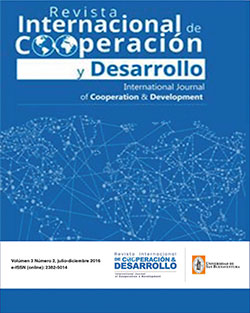Autorización para reproducción, publicación, comunicación y distribución de una obra literaria, artística o científica
Yo, ____________________________________________, autor de la obra y/o artículo, mayor de edad, de la ciudad de _________________, identificado con cédula de ciudadanía/ pasaporte n.°______________________, expedida en _______________________, en uso de sus facultades físicas y mentales, parte que en adelante se denominará el AUTOR, suscribe la siguiente autorización con el fin de que se realice la reproducción, publicación, comunicación y distribución de una obra, en los siguientes términos:
1. Que, independientemente de las reglamentaciones legales existentes en razón a la vinculación de las partes de este contrato, y cualquier clase de presunción legal existente, las partes acuerdan que el AUTOR autoriza a (nombre del editor), para que se reproduzca, publique, comunique y distribuya el material denominado en la Revista Internacional de Cooperación y Desarrollo de la Universidad de San Buenaventura.
2. Que dicha autorización recae en especial sobre los derechos de reproducción de la obra, por cualquier medio conocido o por conocerse, publicación de la obra, comunicación pública de la obra, distribución de la obra, ya sea directamente o a través de terceros con fines netamente educativos.
3. El AUTOR se compromete a informar y declarar la existencia de la presente autorización y a preservar el derecho de la Revista Internacional de Cooperación y Desarrollo a la primera publicación de LA OBRA.
4. El AUTOR declara que el artículo es original y que es de su creación exclusiva, no existiendo impedimento de ninguna naturaleza para la autorización que está haciendo, respondiendo además por cualquier acción de reivindicación, plagio u otra clase de reclamación que al respecto pudiera sobrevenir.
5. Que dicha autorización se hace a título gratuito.
6. Los derechos morales de autor sobre el artículo corresponden exclusivamente al AUTOR y en tal virtud, la Universidad de San Buenaventura se obliga a reconocerlos expresamente y a respetarlos de manera rigurosa.
El AUTOR y/o AUTORES
FIRMA
Resumen
¿Puede tener éxito la integración económica entre un socio rico y relativamente poderoso, y un socio pobre y relativamente impotente en el contexto de tensiones de seguridad entre ellos? Este documento evalúa la realidad económica resultante de los tratados de paz concebidos entre Israel y Palestina, países con intenciones de integración e interdependencia, pero que ha dado lugar a una situación de facto de desarraigo y mayor grado de dependencia económica. Se evaluó el contexto del estudio con base en las teorías mercantilistas y liberales del siglo XVII,. El estudio muestra que las condiciones reales que prevalecen en las relaciones entre Palestina e Israel están muy lejos de las de un contexto liberal. Palestina e Israel no son dos estados soberanos y en paz. Más bien, Israel es un estado soberano y bien establecido con una economía impresionantemente desarrollada, con un ejército fuerte, mientras que Palestina es una nación ocupada sin estado formal, instituciones incipientes, una economía en desarrollo y sin ejército. Además, el contexto de las relaciones palestino-israelíes no es de paz, sino de ocupación y guerra militares. Debido a esta brecha de poder entre las dos partes y el contexto de la ocupación y la guerra, el régimen de facto y las políticas que regulan y actualizan las relaciones econó- micas entre ellos han sido muy diferentes de lo que se establece de jure bajo los actuales acuerdos de integración económica. Por lo tanto, los resultados en términos de desarrollo económico y construcción de instituciones para Palestina no han sido en absoluto lo que se esperaría de un proceso de integración económica entre dos estados libres y bien establecidos en paz unos con otros.
Palabras clave:
Referencias
Aix Group (2004). Economic Road Map.An Israeli-Palestinian
Perspective on Permanent Status. Aix-en-provence: Aix Group. (Research paper) Retrieved from http://aix-group.org/
index.php/2015/10/11/economic-road-map/
Arab World for Research and Development (October 25th, 2008). Results of an Opinion Poll. National Dialogue, Government Performance, Tunnels in Gaza, Palestinian Elections, American
Elections. Retrieved from http://www.miftah.org/Doc/Polls/PollAWRAD251008.pdf
Arnon, A., Spivak, A., Weinblatt, J. (1997). The Palestinian Economy: Between Imposed Integration and Voluntary Separation. Leiden:
Brill.
Arnon, A. and Weinblatt, J. (2001). “Sovereignty and Economic Development: the Case of Israel and Palestine” The Economic
Journal 111: 291-308. DOI:10.1111/1468-
0297.00631
Arnon, A. and Bamya, S. (2007). Economic Dimensions of a Two-State Agreement Between Israel and Palestine. Aix-en-Provence:
Aix Group. Retrieved from http://aix-group.org/index.php/2015/10/10/economic-dimensions-of-a-two-state-agreement-between-israel-and-palestine/
Astrup, C. and Dessus, S. (2005). “Exporting Goods or Exporting Labor?: Long-Term Implications for the Palestinian Economy.” Review of Middle East Economics and Finance 3(1):39-61. DOI:10.1080/14753680500063986
Awartani, H. (1993). “Palestinian-Israeli Economic Relations: Is Cooperation Possible?” In Fischer, S., Rodrik, D., & Tuma, E. H. (Eds.)
The Economics of Middle East peace: Views from the region. Cambridge, MA: MIT Press.
Bahiri, S. (1987). Industrialization in the West Bank and Gaza. Boulder, CO: Westview Press.
Brynen, R. (1995a). “The Neopatrimonial Dimension of Palestinian Politics.” Journal of Palestine Studies. 25(1): 23-36. DOI:
10.2307/2538102
Brynen, R. (1995b). “The Dynamics of Palestinian Elite Formation.” Journal of Palestine Studies. 24 (3): 31-43. DOI: 10.2307/2537878
Brynen, R. (2002). “Donor Aid to Palestine: Attitudes, Incentives, Patronage and Peace.” In M. Keating et al. eds., Aid, Diplomacy and Facts on the Ground. London: Chatham House.
Brynen, R. (2005). Public Finance, Conflict and State Building: the Case of Palestine. McGuille University. Retrieved from https://www.mcgill.ca/icames/files/icames/PalestinePublicFinance2.pdf
Calika, N. (1998). “The Trade System.” In Barnett, S., Calika, N., Chua, D., Kanaan, O., and Zavadjil, M., The Economy of the West Bank
and Gaza Strip. (pp. 51-58) Washington: International
Monetary Fund.
Chua, D. (1998). “Fiscal Policy and its Impact on Private Sector Activity.” In Barnett, S., Calika, N., Chua, D., Kanaan, O., Zavadjil, M., The Economy of the West Bank and Gaza Strip. Recent Experience, Prospects, and Challenges to Private Sector Development. (pp.
41-50) Washington: International Monetary Fund.
Diwan, I., Shaban, R. (1999). Development under adversity: the Palestinian economy in transition. Washington, D.C: The World Bank. Retrieved from http://documents.worldbank.org/curated/en/939611468780603809/Development-under-adversity-the-Palestinian-economy-in-transition
Dessus, S. (2004). “A Palestinian Growth History: 1968-2000” Journal of Economic Integration, 19 (3): 447-469. Retrieved from http://www.jstor.org/stable/23000694
Egger, P. (2005). “The economics of peace:trends and prospects of the Palestinian economy and labour market” International Labour
Review. 144 (1): 31-54. DOI: 10.1111/j.1564-913X.2005.tb00558.x
Farsakh, L. (1998). Palestinian Employment in Israel: 1967-1997, A Review. Ramallah: Palestine Economic Research Institute (MAS).
Heckscher, E. (1936). Revision in Economic History: V. Mercantilism The Economic History Review. 7 (1): 44 – 54. Retrieved from http://
www.jstor.org/stable/2590732?origin=JS-TOR-pdf
International Monetary Fund and World Bank (2006). West Bank and Gaza: Economic Developments in 2006. A First Assessment.
(Report) Retrieved from https://www.imf.org/external/NP/wbg/2007/eng/032607ed.pdf
International Monetary Fund (2008). Macro-economic and Fiscal Framework for the West Bank and Gaza: First Review of Progress.
Staff Report for the Meeting of the AdHoc Liaison Committee. London, May 2nd,2008 Retrieved from https://unispal.un.org/
DPA/DPR/unispal.nsf/85255db800470aa485255d8b004e349a/bdbdc2413d6d0508852574390067f638?OpenDocument
International Monetary Fund (2010). Macro-economic and Fiscal Framework for the West Bank and Gaza: Fifth Review of Progress.
Staff Report for the Meeting of the Ad Hoc Liaison Committee. Madrid: April 13th, 2010 Retrieved from https://unispal.un.org/DPA/
DPR/unispal.nsf/0/FB8C0B0FEA96E-13C852577040063E571
Khan, M. H., Juqmān, J., & Amundsen, I. (2004). State formation in Palestine: Viability and governance during a social transformation. London: RoutledgeCurzon.
Kimmerling, B., and Migdal, J. (2003). The Palestinian People. A History. Cambridge: Harvard University Press.
Michaely, M. (2003). “Goods versus Factors: When Borders Open, Who Moves?” World Economy, 26: 533–553. doi:10.1111/1467-
9701.00536
Naqib, F. (2000). Economic Relations Between Palestine and Israel During the Occupation Era and the Period of Limited Self-Rule. Cariro, Working Paper 2015, Economic Research Forum for the Arab Countries, Iran and Turkey. Retrieved from http://www.erf.org.eg/CMS/getFile.php?id=33
Near East Consulting (November, 2007) “NEC’s monthly poll on the Gaza Strip «Gaza Monitor» Bulletin #4” Retrieved from http://www.
neareastconsulting.com/surveys/gaza/files/GazaMonitor-nov07-fin.pdf
Ofran, H., Etkes, D. (2007). And Thou Shalt Spread … Construction and development of settlements beyond the official limits of jurisdiction. (Report) Jerusalem: Peace Now Settlement Watch. Retrieved from http://www2.hull.ac.uk/fass/pdf/Construction%20and%20
development%20of%20settlements%20beyond%20the%20official%20limits%20of%20jurisdiction.pdf
Palestinian National Authority (2008). “Palestinian
Reform and Development Plan 2008 – 2010”Palestine Ministry of Planning and Administrative Development. Retrieved from http://content.ecf.org.il/files/M00364_PRDP2008-
2010.pdf
Peres, S. (1993). The New Middle East. New York:Henry Holt.
Roberts, N. (2005). “Hard Lessons from Oslo: Foreign Aid and the Mistakes of the 1990s.” In M.Keating et al. eds., Aid, Diplomacy and Factson the Ground. London: Chatham House.
Roy, S. (1999). “De-development Revisited: Palestinian Economy and Society Since Oslo.”Journal of Palestine Studies. 28 (3): 64-82.
Retrieved from http://duncankennedy.net/documents/Is-Pal/Second-Syllabus/Sara%20Roy,%20De-Development%20Revisited.pdf
Samara, A. (2000). “Globalization, the Palestinian Economy, and the “Peace Process”. Social Justice 27 (4): 117-131. Retrieved from http://www.jstor.org/stable/29768039
Schiff, M. W., & Winters, L. A. (2003). Rules of Thumb for Regionalism In: Regional integration and development. (pp. 261-271) Washington, DC: World Bank.
Schiff, M. (2002).Trade policy and labor services:final status options for the West Bank and Gaza. Policy, Research working paper series
WPS 2824. Washington, DC: World Bank.
Schiff, M. (2003). “FTA, Customs Union or Unilateral Trade Policy? Final Status Options for the West Bank and Gaza” Journal of Economic
Integration 18 (1). Retrieved from https://www.jstor.org/stable/23000730
Shafik, N. (1997). “Rents, Reforms and Economic Malaise in the Middle East and North Africa”In Pfeifer, K. (Eds.) Research in the Middle East Economics, 2: 221-245. London: Jai Press.
The Applied Research Institute - Jerusalem (November 2nd, 2008). “Israeli Settlements dramatically expand in the Occupied
West Bank between the years 1996 & 2007.” Retrieved from http://wp.poica.org/2008/11/israeli-settlements-dramatically-expand-in-the-occupied-west-bank-between-the-years-1996-2007/
http://www.poica.org/editor/case_studies/view.php?recordID=1631
The Israeli Information Center for Human Rights in the Occupied Territories (2008). Access Denied. Israeli Measures to Allow Palestinians Access to Land around Settlements. Retrieved from http://www.btselem.org/Download/200809_Access_Denied_introduction_and_Conclusions.pdf
United Nations (1994) Prospects for Sustained Development of the Palestinian Economy in the West Bank and Gaza Strip, 1990-2010: A
Quantitative Framework [Technical Supplement] United Nations Conference on Trade and Development. Retrieved from http://
unctad.org/en/PublicationsLibrary/ecdcseud6a1_en.pdf
The World Bank, World Bank Economic Report to the Ad Hoc Liaison Committee. April 2009.
World Bank (2002) Long-Term Policy Options for the Palestinian Economy. Washington,DC: World Bank. Retrieved from:
http://documents.worldbank.org/curated/en/221761468780560580/Long-term-policy-options-for-the-Palestinian-economy
World Bank (2006a) West Bank and Gaza Country Economic Memorandum. Growth in the West Bank and Gaza: Opportunities and
Constraints. Vol. 1, Main Report.(Report No.36320) Washington, DC: World Bank. Retrieved from http://documents.worldbank.org/curated/en/604121468321249713/Main-report http://documents.worldbank.org/curated/
en/604121468321249713/Main-report
World Bank (2006b) West Bank and Gaza Country Economic Memorandum. Growth in the West Bank and Gaza: Opportunities
and Constraints. Vol 2, Annexes (Report No. 36320) Washington, DC: World Bank. Retrieved from http://documents.worldbank.org/
curated/en/860591468176645582/Annexes
World Bank (2007a). Investing in Palestinian Economic Reform and Development, presented at the Pledging Conference. Paris, December 17th. Retrieved from http://siteresources.worldbank.org/INTWESTBANKGAZA/Resources/294264-1166525851073/ParisconferencepaperDec17.pdf
World Bank (2007b) Movement and Access Restrictions in the West Bank: Uncertainty and Inefficiency in the Palestinian Economy.
Washington, DC: World Bank. Retrieved from http://documents.worldbank.org/curated/en/964061468339036297/
Movement-and-access-restrictions-in-the-West-Bank-uncertainty-and-inefficiency-in-the-Palestinian-economy
World Bank (2007c) West Bank and Gaza Energy Sector Review. Sustainable Development Department (MNSSD) Middle East and North Africa Region, (Report No. 39695-GZ). Retrieved from https://unispal.un.org/pdfs/WBReportNo39695-GZ.pdf
World Bank (2007d) West Bank and Gaza Public Expenditure Review. From Crisis to a Greater Fiscal Independence (Report No. 38207) Washington, DC: World Bank.http://documents.worldbank.org/curated/en/252421468137111024/Summary
World Bank (2007e) West Bank and Gaza – Investment
Climate: Unlocking the Potential of the Private Sector. Washington, DC: World Bank. Retrieved from https://openknowledge.worldbank.org/handle/10986/7792
World Bank (2008) West Bank and Gaza Telecommunications
Sector Note: Introducing Competition in the Palestinian Telecommunications Sector. West Bank and Gaza Telecommunications sector note.
Washington, DC: World Bank. Retrieved from http://documents.worldbank.org/curated/en/164111468321245459/
West-Bank-and-Gaza-telecommunications-sector-note-introducing-competition-in-the-Palestinian-telecommunications-sector
World Bank (2009a) World Development Report 2009: Reshaping Economic Geography. Washington D.C.: World Bank. Retrieved
from https://openknowledge.worldbank.org/handle/10986/5991
World Bank (2009b) Palestinian economic prospects: Gaza recovery and West Bank revival - economic monitoring report to the
Ad Hoc Liaison Committee. (Report No. 76017) Washington D.C.: World Bank. Retrieved from http://documents.worldbank.
org/curated/en/709691468135299362/Palestinian-economic-prospects-Gaza-recovery-and-West-Bank-revival-economic-monitoring-report-to-the-Ad-Hoc-Liaison-Committee














